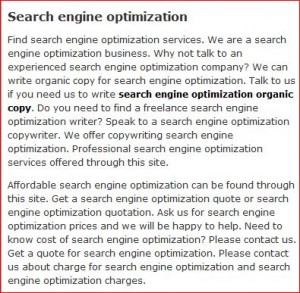Entries Tagged 'copywriting' ↓
March 28th, 2011 — copywriter, copywriting, copywriting tips, marketing, sales writing, UK copywriter
Can you really tell whether copy is good or bad just by looking at it?
The answer is yes and no.
It rather depends on what the copy is, what it’s meant to do and what form it takes.
For example if it’s SEO copywriting and it’s very obvious what the targeted keyword is, like in the example below…

…then it’s pretty safe to say it’s bad copy.
The problem is a section of text can be very well written (grammatically correct and no spelling errors) and yet, from a sales perspective, it’s about as useful as a chocolate teapot.
That’s why it’s not always easy to spot bad copy.
It’s probably easier to look at this from a different angle and think about what makes good copy.
The traits of good copy
Luckily there are 5 characteristics that good copy has. No matter which format it’s written for or what it’s trying to sell, good copy will always:
- Grab the readers’ attention immediately
- Be clear and unambiguous
- Answer all the readers’ questions and so counter any buying objections they may have
- Build trust and rapport with the reader
- Motivate the reader into taking a specific action through a strong call to action
What it comes down to is this – copy is written for a purpose (generally to sell something) but if it doesn’t fulfil that purpose it’s not doing its job.
Selling through text alone is difficult. You don’t have the personal contact with the customer; you can’t think on your feet to counter their buying objections and you can’t shake their hands.
Your copywriting has to do every thing:
- Inform
- Build trust
- Convince
- Convert into a sale
That’s not an easy thing to achieve.
What are your thoughts? Can you think of any more traits you find in good copy? Why not share them here along with any shocking examples of copy you’ve come across.
March 23rd, 2011 — copywriter, copywriting, copywriting tips, website copywriter, website copywriting

Many businesses think their website copy has to be stiff and corporate.
They want to come across as professional so they must use language that impresses.
As they write their copy they thumb through the pages of their much loved thesaurus to find the most impressive words possible.
Oh boy.
How many times have I seen that? And you know what? They are the websites that under perform because no one wants to read them because they are boring. The language is stale – it’s not interesting, it’s not inspiring and it certainly won’t make the reader think “wow, I really want to do business with these people.”
Be a friend
The best way to get your readers on your side is by chatting with them.
Conversational copywriting will make your website more accessible. It gives your company a distinctive voice – something your readers can relate to.
It’s like slipping on your favourite slippers. They’ll stay longer and they’ll read more because you are talking to them and not at them.
So how can you achieve chatty copy?
- Find out who your target market are and use their vocabulary
- Use short, clear sentences to get your message across
- Don’t use big words – throw away the thesaurus and use language everyone understands
- Read your copy out loud to check it makes sense, has rhythm and doesn’t contain any errors
- Use real language, not a literary version of it
Basically write as you would talk – go over the conversation you would have with the customer if you were stood in front of them and write it down.
March 21st, 2011 — copywriter, copywriting, copywriting tips, freelance copywriter, internet marketing, marketing, website copywriter, website copywriting
 In the world of marketing you’ll soon discover that very few people like being sold to.
In the world of marketing you’ll soon discover that very few people like being sold to.
We want to be sure our decisions are our own and not influenced by someone else.
That’s why very few people will land on a website, think “Wow! I must buy that now” and eagerly get out their credit card.
Before any of us buy (yes, you included) we have doubts – is it really what I need? Can I really justify the cost?
The art of a good copywriter is to overcome those objections within their copy which means getting out their crystal ball.
Why?
Because you have to counter their objections before your reader has had the opportunity to work out what they are.
Copywriting that convinces
Whenever you are faced with a buying decision all manner of objections are going to pop into your head. The copywriter has to pre-empt these because copy isn’t about getting the consumer to say ‘yes’, it’s about preventing them from saying ‘no’.
Here are some common objections:
1. I don’t need it
Let’s face it there aren’t that many things we buy that we actually need. Needing something is about not being able to function with out it. To get round this one you have to change that ‘need’ into a want.
I don’t need the small mountain of shoes I have in the bottom of my wardrobe, but I want to look coordinated, stylish and modern hence I want lots of different pairs to go with my different outfits.
2. I can’t afford it
With the current economic climate there’s not a lot left we can afford.
But again if you can convince them they want it they’ll find the money from somewhere. Give them a good enough offer and they’ll just have to buy.
3. Perhaps tomorrow?
If you let them browse and then walk away, they are very unlikely to come back again.
You have to force them into a decision there and then:
- Create a time limited offer
- Tell them there is a limited supply
- Tell them they only have until midnight to place their order or miss out on the offer of a lifetime.
4. Why should I buy from you?
You know you are honest and trustworthy but the consumer doesn’t.
They have just stumbled across your website and don’t know you from Adam. Through your copy you have to convince them of your trustworthiness through:
- Testimonials
- Background information on your company
- Details of your longevity
Your copy must entice, convince and sell if you are to draw in the punters. Remember you have to dispel their objections before they have the opportunity to raise them.
February 11th, 2011 — become an expert, copywriting, freelance copywriter, internet marketing, marketing, social media, social media marketing, social networking
 Social media can be useful for every part of your business.
Social media can be useful for every part of your business.
It’s not and should not be used solely as a tool for self-promotion. If you do that you’ll be about as popular as a skunk in a broken lift.
In the good old days the only way customers could get in touch with you was by phone or letter. If they were disgruntled they would moan to their friends about your service and products and you’d probably be none the wiser.
But now, they won’t just talk to their friends. Social media has given them an incredibly loud voice so if they’re unhappy about something, it won’t be long before the whole world knows about it.
How to use social media to your advantage
Monitoring social media channels can help practically every part of your business.
People love to talk and if you listen carefully you can learn a lot about their habits, their likes, their dislikes and their needs.
1. Sales
So let’s take a look at how social media can help your sales department.
The ideal time to sell to someone is when they’re ready to buy. But that’s not easy. Say you were a local electrical retailer and were looking to push a new line of washing machines. Monitoring social media channels will help you identify people who are asking advice about which washing machine to buy or those who are moaning because theirs has just broken etc.
By responding, making contact and offering advice puts you in the right place at the right time – when they’re ready to buy.
2. Marketing
Can it help with marketing?
Oh yes. Listening to your target market will give you an idea of whether what you’re saying and what they think are aligned. Do your marketing materials answer the questions they raise? Are you speaking the same language as them?
Many companies have the odd idea that they have to speak in a language all of their own. Their words have to sound impressive and convoluted – they think that’s what their customers will be impressed by.
Wrong. Customers want straight talking. If you’re a window cleaner call yourself that rather than a vision technician.
3. Customer service
As for customer service, that one speaks for itself. I’ve already mentioned how useful social media is for disgruntled customers so make sure you’re listening. If someone has received bad service, make contact straight away and put it right.
This rapid response shows you as a company that cares about its customers. So you could turn a bad situation to your advantage.
4. Development
You’ve probably got your R&D boffins locked away somewhere trying to come up with ways to improve your products.
But surely it’s your customers you should be listening to?
Social media channels will let you eaves drop on their conversations about what they would really like your products to do. You can even ask them directly to do a bit of customer research.
5. Human resources
Yes, social media can even help your HR department.
How?
Well social media users have profiles showing their skills and experience. You can search for specific talent that your company needs. You can even see what connections they have. Head hunting has never been so easy.
So as you can see, social media can help practically every aspect of your business. These online channels are a direct link between you and your customers so use them.
Sally Ormond – freelance copywriter, blogger and social media addict.
November 26th, 2010 — copywriter, copywriting, copywriting jobs, freelance copywriter

As a freelance copywriter, in my perfect world I would be able to generate an unlimited number of original ideas at the drop of a hat.
I would never be stumped by a project, and subject-matter for my blogs, articles, client web copy, emails and newsletters would flow freely without any effort on my part.
But sadly it’s not a perfect world and, yes even I suffer from writers’ block every now and then. I have been known to be sat in front of my PC waiting for inspiration to strike. Only the number of empty coffee mugs littered across my desk betrays the length of time I’ve been wracking my brain trying to come up with a winning concept.
So how can you get over a barren spell?
The simple answer is a swipe file.
As I read newspapers, magazines, mail shots, websites and emails I make a note of anything that grabbed my attention.
If a particular layout was particularly effective or an image suitably eye-catching – anything that made me stop and read, it goes in my swipe file.
One word of warning—a swipe file is not there to be directly copied or plagiarised—a swipe file is there for inspiration.
After all if a headline grabbed your attention it will probably grab others’; if an email subject line made you open it others will too; if the layout of an advert made you stop and take notice others will also stop.
Over time you will build up a reference tool of hundreds of ideas to which you can add your spin.
Let others inspire you to create copy that sells.


 In the world of marketing you’ll soon discover that very few people like being sold to.
In the world of marketing you’ll soon discover that very few people like being sold to. Social media can be useful for every part of your business.
Social media can be useful for every part of your business.





